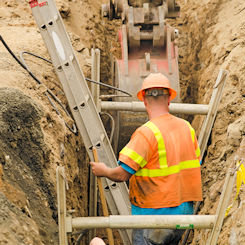The Hazards
Trenching and excavation work presents serious hazards to all workers involved.
Cave-ins pose the greatest risk and are more likely than some other excavation-related incidents to result in worker fatalities. One cubic yard of soil can weigh as much as a car. Employers must ensure that workers enter trenches only after adequate protections are in place to address cave-in hazards. Other potential hazards associated with trenching work include falling loads, hazardous atmospheres, and hazards from mobile equipment.
During a residential construction project in Beaverton, Oregon, two workers were found inside a trench approximately 3 feet wide, 12 feet long, and over 5 feet deep. No protective systems were in place — such as shoring, shielding, or sloping — to prevent a collapse.
The trench’s narrow width and unstable walls created a serious risk. Even a minor shift in the soil could have triggered a cave-in, which can trap and fatally injure workers in seconds.
No injuries occurred, but the situation exposed workers to a significant and immediate danger, in direct violation of excavation safety standards.
Investigation findingsAn investigation by Oregon OSHA found the company had no effective system in place to manage trench safety — despite being aware of the risks associated with excavation work.
The company also failed to assign a trained, competent person to identify and address trench hazards, and did not protect workers from the risk of falling debris at the trench face.
The company was cited for multiple safety breaches under the Oregon Safe Employment Act and was fined a total of $80,804.
Recommendations for employers- Always implement appropriate trench protection systems (e.g., shoring, shielding, or sloping) for excavations deeper than 5 feet.
- Designate a trained, competent person to assess excavation sites for hazards before and during work.
- Ensure all workers are protected from falling materials by using protective gear and proper trench face supports.
- Educate employees regularly on excavation safety protocols and legal obligations.
In 2022, a 17-year-old worker suffered fatal injuries after being struck in the head by a large chunk of asphalt, and a company foreman was injured that same year when an unprotected section of excavation wall caved-in. The employees were working for a contractor on a residential sewer connection.
After an investigation, OSHA issued a serious citation and financial penalty to the contractor for its violation of federal law. Several years later, having failed to take adequate measures to protect its employees, the contractor faces over $200,000 in proposed penalties.
Trenching standards require protective systems on trenches deeper than 5 feet, and soil and other materials kept at least 2 feet from the edge of a trench. Additionally, trenches must be inspected by a knowledgeable person, be free of standing water and atmospheric hazards and have a safe means of entering and exiting prior to allowing a worker to enter.
Excavation vs. Trench
Dig a hole in the ground and you've made an excavation. Excavations can be any size: wide, narrow, deep, or shallow.
A trench is a narrow excavation, not more than 15 feet wide at the bottom. If you install forms or other structures in an excavation that reduce its width to less than 15 feet, measured at the bottom, the excavation is also considered a trench.
- If you work in an excavation that's five feet deep (or deeper) you must be protected from a cave-in.
- If a competent person, who has training in soil analysis, determines that there's a potential for an excavation to cave-in, you must be protected regardless of its depth.
Knowledge Check Choose the best answer for the question.
1-1. A _____ is not more than 15 feet wide at the bottom.
You forgot to answer the question!

